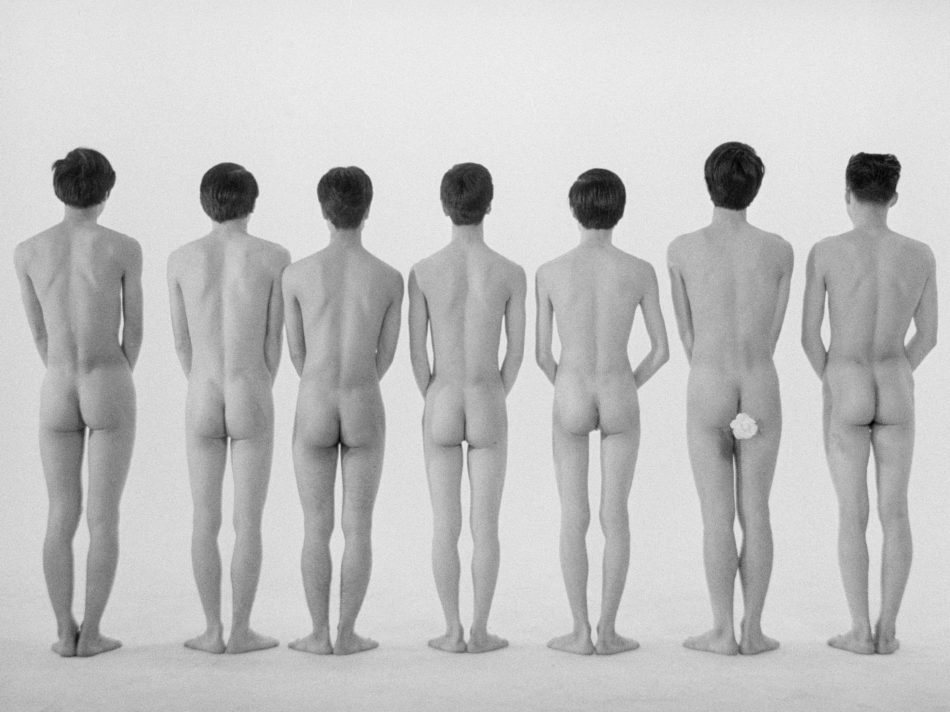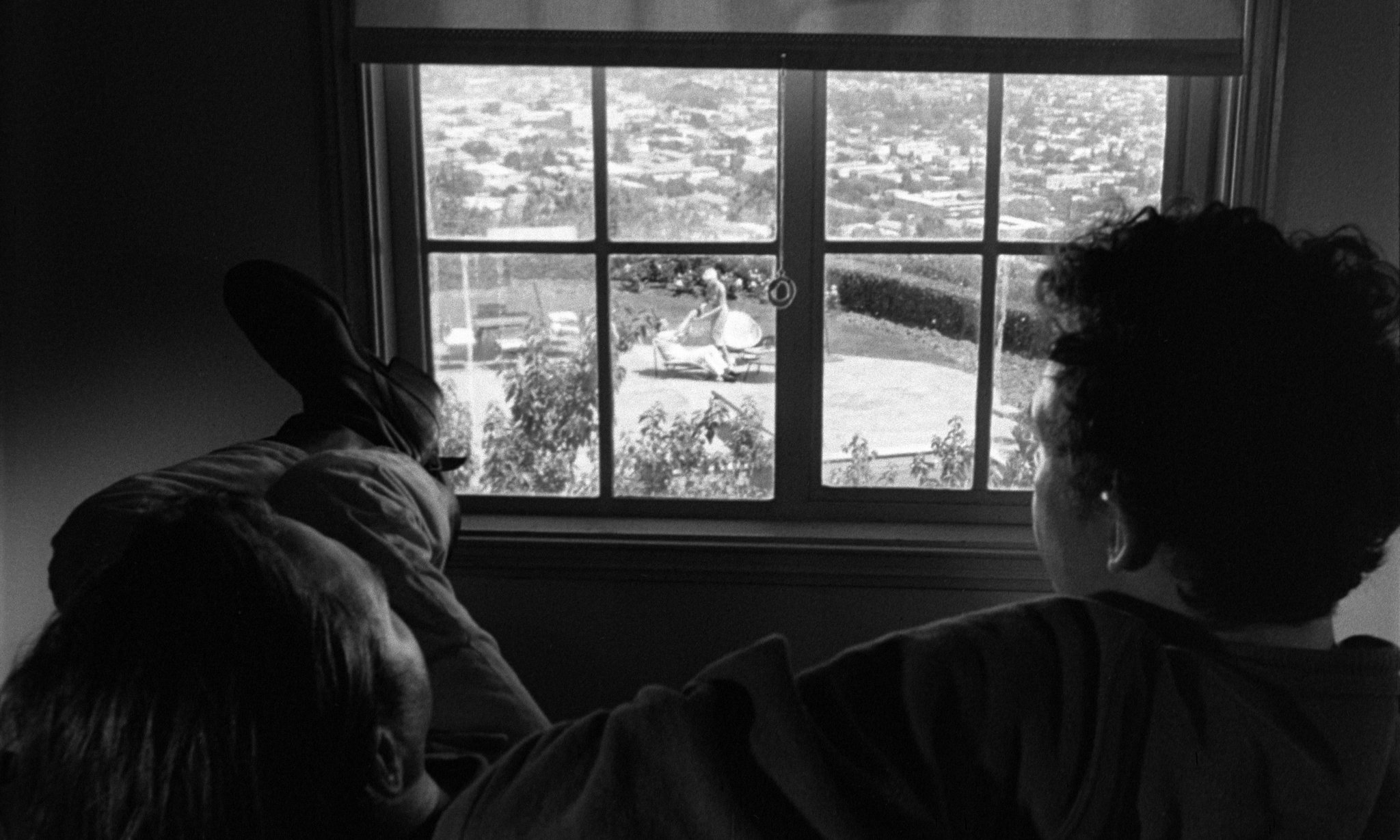
By Marc Francis
About a third of the way into Funeral Parade of Roses, Eddie and her friends decide to take a break from shopping to use the lavatory. Cut to the three transgender youth at urinals in a public restroom, their backs to the camera. As soon as the audience has had enough time to register the juxtaposition of the women’s attire against their chosen spot of relief, a man walks in, does a double take, and flees the scene. At this moment, a censor flashes on the screen, suggesting that the EIRIN—the Japanese version of the MPAA—has intervened and deemed this content obscene. If it wasn’t for the comedic timing, the audience might be led to believe that a chunk of film was actually banned.
Despite its humor, watched today, this scene seems to eerily foreshadow a paranoia that has run rampant through today’s United States. This Cinelicious restoration arrives in a time in which one cannot help but think of recent measures that have been taken to oppress transgender individuals, in issues as far reaching as their bathroom selection to their right to serve in the military. It is highly unlikely that the director Toshio Matsumoto intended for this scene, nor the film as a whole, to bear such direct political weight vis-à-vis queer bodies. So why did Matsumoto, a heterosexual director, gravitate towards drag, androgyny, and homosexuality in adapting the story of Oedipus Rex to Tokyo’s queer underground art scene? What politics was he seeking to activate?
On the one hand, Funeral Parade of Roses is a quite linear adaptation of Sophocles’ Ancient Greek play Oedipus Rex. Eddie is a transgender hustler who works at Club Genet, a meeting place for drag queens, queers, artists, and “straights” of many persuasions. Eddie is entangled in a love triangle with one of the club’s patrons, Gonda, and the club’s madame, Leda, who also vies for Gonda’s affections. We later learn that Gonda is Eddie’s absent father, in turn driving the main characters to self-inflicted violence or suicide. On the other hand, this linear story is continually disrupted. Matsumoto incorporates interviews with the film’s queer leads as well as anonymous subjects seemingly found on the street. “Why did you become a gay boy (gei-boi)?” a voice behind the camera asks one anonymous subject, who replies with a smile and simply states, “because I like it.” Footage from protests and “happenings” or guerilla performances on the streets of Shinjuku, the Tokyo district where gay bars and art spaces clustered, also find their way into the film. These help form a collage of Tokyo’s sociopolitical moment alongside and woven into the fictional narrative.
The fact that Matsumoto decided to adapt the story of Oedipus is perhaps one of the most baffling and ambiguous aspects of Funeral Parade of Roses. What is most curious is that the film does not try to rigidly transplant the ancient tragedy to 1969 Tokyo but instead mobilizes it as as an experiment in queer kinship. The film explores whether or not Sophocles’ tale and Freud’s conceptualization of the Oedipus complex do in fact hold water when the entire notion of family has been radically reconfigured, especially within the queer community. This is perhaps why the film’s final scenes of violence highly reference other sources than just the original Oedipus Rex. Leda, after committing suicide, lays in a bed surrounded by roses in a fashion that recalls John Everett Millais’ Ophelia. Eddie’s father, Gonda, stabs himself in a fashion that may for some invoke the ritual practice of seppuku, one year before the infamous queer masculinist-nationalist author Yukio Mishima would commit honorable suicide after a failed coup d’état attempt. Given these references, questions of intertextuality, national identity, and familial redefinition trouble any straightforward telling of the Oedipal narrative, here repurposing it as fodder for multiple yet elusive interpretations.
Funeral Parade of Roses, like many of its avant-garde counterparts of the time, runs the risk of using queerness to solely allegorical ends. It was common at this moment for critics and programmers to position homosexuality and other queer variants as part of a work’s larger provocation and oddity rather than as subjectivities necessitating representation in their own right. Alternatively, Funeral Parade of Roses uses interview and documentary footage with actual Tokyo-based queer non-professional actors. This approach pulls the film back from a cooptive impulse that might relegate queerness a mere thematic device. Here I will describe how Matsumoto’s hybrid modernist experiment can be retrofitted to the queer canon of experimental work by the likes of Kenneth Anger and Jack Smith. And perhaps most striking is that the film anticipates a moment in queer filmmaking to come.
Strangely, Funeral Parade of Roses was criticized in Japan for not being political enough. Granted, there was cause for alarm in 1969 Japan. The US-Japan security treaty that had allowed the US to virtually occupy Japan for over a decade was up for renewal. The students took to the streets in protest against Japan’s acquiescence. To exacerbate matters, Tokyo’s urban space was undergoing a massive transformation that would set the stage for the 1970s corporate takeover. For many critics in Matsumoto’s art-house circles, Funeral Parade of Roses failed to meet the urgency of the times.
For U.S. cinephiles, Toshio Matsumoto may have seemed to bust onto the scene out of nowhere when Funeral Parade of Roses first screened at the 1970 San Francisco International Film Festival. In reality, however, the director, artist, and writer had been a core member of the Tokyo underground or angura art community for well over a decade. Shape shifting throughout the years following his graduation from Tokyo University in 1955, Matsumoto worked as a director at Iwanami Films (a company full of left-wing filmmakers who, ironically enough, produced public relations films), film programmer at the Sogetsu Art Center (a crucial site for the exhibition of experimental films at the time), and editor for the journals Film Arts (Eiga Geijutsu) and Film Quarterly (Kikan Firumu) (the latter of which was co-edited by prominent director Nagisa Oshima), all the while producing his own experimental short films.
Throughout the late 1950s and early 1960s, Matsumoto published several articles that outlined a radical filmmaking practice that would merge documentary ethos with formal experimentation. According to Matsumoto, avant-garde practice had for too long focused on the interior workings of the unconscious or served as apolitical stylistic exercises. On the other end, the Griersonian documentary tradition had tried to rigidly represent a supposed objective world. The “neo-documentary,” as Mastumoto called it, aimed to resolve this by putting the two in fruitful collision. His two short films Nishijin (1961) and The Song of Stone (Ishi no uta) (1963), both of which depict the exploitation of factory laborers, epitomize this dyadic aspiration through its reverberations of Dziga Vertov’s work. But it is Funeral Parade of Roses that serves as the apex of his theoretical ambitions. As Matsumoto describes the film, echoing his notion of “neo-documentary,” “my creative intent was to disturb the perceptual schema of a dualistic world dividing fact from fiction, men from women, objective from subjective, mental from physical, candidness from masquerade, and tragedy from comedy.”
Funeral Parade of Roses embraces an oscillatory interplay of styles, thus producing a dizzying impression of a historical time and place that brims with uncertainty. Undoubtedly, this Cinelicious restoration thrives on this incendiary aesthetic convergence. Now we are able to see and feel the vibrancy of the Tokyo streets and markets in the guerrilla-shot documentary footage. (Few will be surprised to hear Matsumoto could not acquire a permit to shoot on the streets and, as a result, did it surreptitiously.) In the film’s more expressionistic moments, the viewer can even discern the strands of hair on Eddie’s head in close-up shots. In one sequence, where the film had been solarized, the outlines of the bodies are now near tactile in their delineation.
The restored crispness of the image and sound in this version also endow the interview sequences with a necessary vitality. From one perspective, the interviews might seem just another New-Wave technique that draws spectators’ attention to the film’s means of production. But viewed another way, the interviews allow the film’s actors to break from their roles, thus enabling a dialogue with the fictionalized presentation to form. For instance, one interview subject is asked about her aspirations and whether or not he wants to get married and have a family. The subject replies that in lieu of pursuing a normative family life, he would like to open a bar one day. In several of the interviews, the interviewer asks the subjects if they are happy. Many viewers will be reminded here of Jean Rouch and Edgar Morin’s existential premise in the influential cinema verité classic Chronicles of a Summer (1961), where the makers indeed begin by asking participants, “Are you happy?” In Funeral Parade of Roses, the interviews reach beyond a fictional narrative containment to show that queers of all kinds have real-world dimension and are here indeed thriving within the bounds of the Shinjuku district.
The interview insertions also rescue the film from having an ethnographic gaze. Black feminist cultural critic bell hooks once accused the drag-ball classic Paris is Burning of such an infliction, given that white director Jennie Livingson rendered herself invisible behind the camera. In Funeral Parade of Roses, not only do we hear Matsumoto’s voice as he asks the subjects personal questions, but there is even one attempt to reveal the camera apparatus and entire crew setup during a sex scene between Eddie and one of her johns. Matsumoto therefore positions himself an interlocutor rather than a truth-teller of the trans or queer experience.
By giving glimpses into its process, Funeral Parade of Roses becomes a document of the avant-garde itself—not only of its stylistic and ideological aims, but also of its ability to capture an array of countercultural phenomena at the time: the student movement, expanded drug use, free love, performance art or “happenings,” and the emergence of more public homosexual and transgender identities. Several scenes, including one where Eddie dresses the wounds of an injured protestor she finds in her apartment building staircase, allude to these colliding worlds.
One of the queerest moments in the film, funny enough, is when a group of filmmakers and the Club Genet youth get stoned in a basement and dance and play games that lead them to disrobing down to their underwear. The male, female, and trans bodies that converge in this space resist, through their anarchic pleasure seeking, the hegemonic codes of propriety that have been impressed upon them. It is for this reason that the venue is called “Club Genet” rather than, say, “Club Wilde.” Like writer Jean Genet’s corpus, the space symbolizes an effort to push perversions and politics to their limits.
Funeral Parade of Roses’ investment in these deviant bodies’ vulnerabilities is clear from the very first shot. The film begins in the same way as Alain Renais’s classic Hiroshima Mon Amour (1959). Two nude bodies caress one another in bed, their faces largely obscured. The two figures appear to be heterosexual before it is revealed that both are in fact men, at least based on an anatomical notion of gender. Matsumoto, who was greatly influenced by Renais, redeploys Hiroshima Mon Amour’s iconic opener to make the viewers aware of their gendered preconceptions. In this sequence, among many others, Matsumoto makes a case for the malleable performance of gender itself, and cinema’s participation in this performance by sheer virtue of the medium’s formal qualities of editing, composition, lighting, etc.
For Matsumoto, gender is a mask that one wears. In one scene, Eddie finds herself dizzy and overwhelmed by triggered childhood flashbacks, and stumbles from an alleyway into a gallery space. (Note that the alleyway wall on which Eddie leans is plastered with posters for Pier Paolo Pasolini’s Oedipus Rex [1967].) On the walls of the exhibit hang drawings of mangled faces, accompanied by an audio recording of an essay on masks. Upon first seeing and hearing this, it is easy for a viewer to assume that the film frames Eddie’s cross-dressing as merely imitative, as a masquerade that hides the true self. Masquerade has long been part of theories on gender, from Joan Riviere to Mary Ann Doane to Judith Butler. In this writing, the mask is inherently a question of utility; it is a deception through which a person can wield power. On the contrary, Matsumoto regards masks as not just veils that hide a person’s identity but as tools of expression that enable different facets or layers of an identity to shine through. The interplay between gender concealment and revelation throughout the entire film can be seen as involving this mask work. It is a means through which to explore one’s multiple and protean understandings of the self in relation to one’s surroundings.
Unsurprisingly, Funeral Parade of Roses was shown alongside two other queer classics that are often cited for their subversive play with gender norms at an early screening in the U.S.: Jack Smith’s Flaming Creatures (1963) and Jean Genet’s Un chant d’amour (1950). Additionally, Matsumoto has cited Kenneth Anger’s Scorpio Rising (1963) as an influence, which he considers to have, like Funeral Parade of Roses, merged experimental and documentary aesthetics to give a unique record of a time, place, and subculture.
The film’s programming history alone indicates it has been of interest to queer viewers, especially in the U.S., in the decades that followed its initial release. The film was programmed at the San Francisco International Film Festival in 1970 by queer program director Albert Johnson. Three years later, it was brought to New York City, where Brazilian and also queer programmer extraordinaire Fabiano Canosa exhibited it at the First Avenue Screening Room. In 1982, the film was revived at the San Francisco International Lesbian and Gay Film Festival (later renamed “Frameline”). The film’s programming lineage here makes apparent that the film spoke directly to queers, and was able to position queerness as more than just an object of curiosity or provocation but as something of substance worthy of further reflection.
Funeral Parade of Roses also fits within a later trajectory of queer film history. Avoiding the thorny assertion that the film serves as a precursor, one could argue nevertheless that it anticipates the aesthetics of the moment known as New Queer Cinema. New Queer Cinema, as a subset of the early 1990s indie film movement, was in part a response to the devastation brought on by HIV/AIDS. As many have pointed out, these films depict queer time that is out of joint, a symbol of crippling illness and premature death. Many of these films reflected on the queer time by appropriating and “queering” historically significant plays and stories (the Leopold and Loeb murders in Tom Kalin’s Swoon (1992), Christopher Marlowe’s Edward II in Derek Jarman’s film of the same name (1991), Langston Hughes’s poetry in Isaac Julien’s Looking for Langston (1989), among many more), just as Funeral Parade of Roses queers the Oedipal narrative. Eddie’s flashbacks to her childhood, brimming with psychoanalytic undertones, also resonate with Todd Haynes’s meditations on queer boyhood in Dottie Gets Spanked (1993) and Poison (1991).
Matsumoto’s commitment to a modernist style that can combine an index of lived experience is what sets his work apart both within the Japanese film canon as well as the larger paradigm of 1960s New Wave currents that coursed through South America, Europe, the U.S., and East Asia. It is rare, if not impossible, to find a queer representation within the New Wave as bold and unflinching as the one here. In many ways, Funeral Parade of Roses is a product of its time as well as ahead of it. It manages to animate many of the tenets of queer theory, including gender as a social construction, even before the discourse formed by the 1990s. Perhaps with this restoration, Funeral Parade of Roses can earn its rightful place in the queer canon, where deviance of all sorts find their rightful home.
Marc Francis is a PhD candidate in the Department of Film and Digital Media at University of California, Santa Cruz. His work focuses on queer film and media. His essays have appeared in Camera Obscura, Jump Cut, and Film Quarterly. In addition to his text-based scholarship, he curates an LA-based film series called Wayward Cinema. He also serves as Editorial Assistant for Film Quarterly.





